Ripon Cathedral
OS grid reference:- SE 316 712
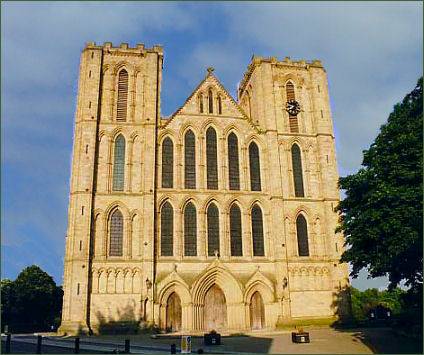 Ripon Cathedral in the small North Yorkshire city of Ripon is a seat of the Bishop of Leeds.
Ripon Cathedral in the small North Yorkshire city of Ripon is a seat of the Bishop of Leeds.
History
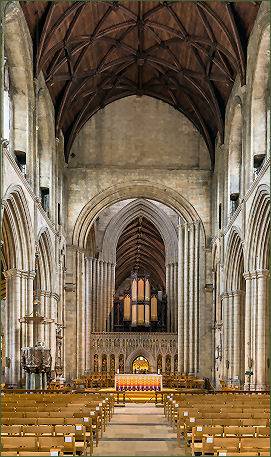 A church has occupied the site of the present cathedral for almost 1,400 years. The present building is the fourth church to occupy the site.
A church has occupied the site of the present cathedral for almost 1,400 years. The present building is the fourth church to occupy the site.
The first building was an Anglo-Saxon timber church founded by Celtic monks from Melrose Abbey in Scotland. This structure was replaced in stone by a church dedicated to St Peter by St. Wilfrid in 672, who brought stonemasons, plasterers and glaziers over from France and Italy to work on the building. Stephen of Ripon recorded-
"In Ripon, Saint Wilfrid built and completed from the foundations to the roof a church of dressed stone, supported by various columns and side-aisles to a great height and many windows, arched vaults and a winding cloister."
St. Wilfrid was one of the most influential and controversial figures in the early English church in the seventh century. He was born into an aristocratic Northumbrian family in 634, and joined the monastery of Lindisfarne in his teens, before making the first of his three jorneys to Rome.
On his return journey to England, he spent three years with the Bishop of Lyons, where he became steeped in the ways of the continental church. Upon his return to Northumbria in 658, he was given the recently founded monastery of Ripon to be its Abbot. He also introduced the Benedictine Rule for his monks and promoted the most up-to-date Roman customs, including the singing of plainchant.
This church was one of the earliest stone buildings to be built in the Anglo-Saxon Kingdom of Northumbria. The crypt of the present building, one of the oldest in the country, dates back to this period, a simple structure, it is said to be built in imitation of Christ's tomb. It remains almost as Wilfrid described it. The main chamber is entered by way of dark passages, one of the relics which Wilfrid had brought back from Rome was displayed in the eastern niche. Saint Wilfrid died in 709 and was buried in the church near the high altar.
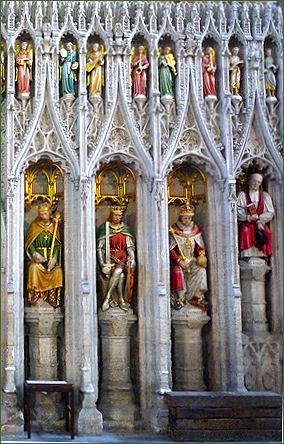 In 875 the monastery was sacked by raiding Vikings. Sometime after 978 it was rebuilt once more, by Bishop Oswald, who intended it to serve secular priests.
In 875 the monastery was sacked by raiding Vikings. Sometime after 978 it was rebuilt once more, by Bishop Oswald, who intended it to serve secular priests.
The church was again devastated during the reign of the Saxon King Edred in 948 as a warning to Wulfstan, the Archbishop of York, who had formed an alliance with the Viking ruler of York, Eric Bloodaxe. King Edred marched north with an army and ravaged the province, burning Ripon. Only the crypt of the cathedral survived. The crypt was built in imitation of Christ's tomb, it is very simple, with whitewashed walls with small niches to hold candles, and a simple altar table. A large niche on the east wall may have been made to hold the relics of saints brought back by St. Wilfrid from Rome. It now houses a fourteenth century alabaster carving depicting the resurrection of Christ. The carving was part of a hidden stash found beneath the Dean's stall in the choir during Victorian restoration work. It was probably concealed there to protect it from damage during the iconoclasm of the Reformation, when many works of religious art were destroyed.
A second minster was constructed at Ripon by Bishop Oswald, but met the fate of the first, this time in 1069 at the hands of William the Conqueror during his merciless 'Harrying of the North' in response to Saxon resistance to his rule. Thomas of Bayeux, the first Norman Archbishop of York, commenced the construction of a third church.
The Early English west front was added in 1220, its twin towers originally crowned with wooden spires and lead. The west front is one of the best examples of Early English Gothic architecture in England. To enter the nave, visitors pass through the great glass doors which were added in 2012. These depict scenes from the life of St Wilfrid.
The nave was mostly rebuilt in the Perpendicular or late Gothic style after the central tower collapsed in 1450. Major rebuilding was postponed due to the outbreak of the civil war now known Wars of the Roses but resumed after the accession of the first Tudor king Henry VII in 1485. The nave was widened and the central tower partially rebuilt.
In 1547, before this work was finished, King Edward VI dissolved Ripon's college of canons. All revenues were appropriated by the Crown and the tower never received its last Perpendicular arches. It was not until 1604 that the first Stuart king, James I issued his Charter of Restoration and it was once again became a collegiate church.
The charter was again revoked after the establishment of the Commonwealth under Oliver Cromwell. In 1660, King Charles II restored the charter after the restoration of the monarchy. The minster became the focal point of the newly created Anglican Diocese of Ripon in 1836, the first to be established since the Reformation, and was made a Cathedral.
The Building
The ancient Saxon crypt, one of the oldest in the country, is the only part of Wilfrid's original church that has survived to the present. Other Saxon remains in the cathedral include a late ninth century cross head, a century grave marker dating to the eighth century, a seventh century altar pillar and cross base in the crypt, late eighth century string courses in a corner of the north transept, and a carved capital in the Chapel of the Ressurection which dates back to the seventh century.
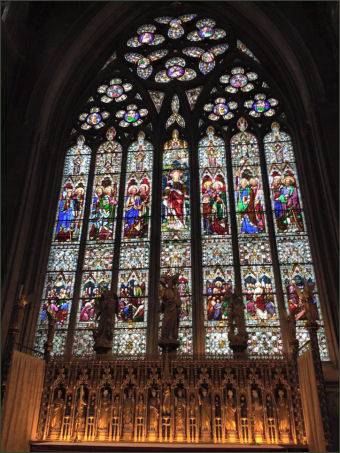
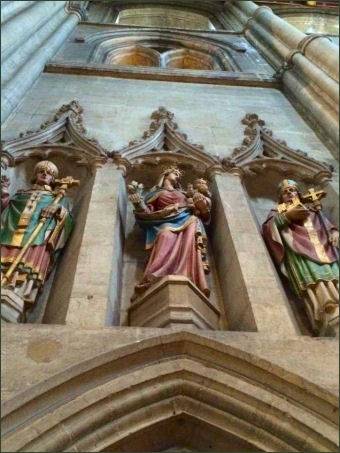
The cathedral has a fine organ built by Harrison and Harrison which dates from 1926. The organ is on the screen and has casework by Gilbert Scott. The pulpit was made by Henry Wilson in 1913 and has both both Arts and Crafts and Art Nouveau influences. Around the sides are bronze images of four Northern Anglo-Saxon saints, St. Chad, monk of Lindisfarne and bishop of Lichfield, St Hilda, Abbess of Whitby, and St Etheldreda, a Northumbrian queen and founder of the abbey at Ely.
Some of the other highlights of the building are the fourteenth century century sedilia and a fourteenth century library which is situated above the chapter house . The library was originally a chapel, but it now used to house the cathedral Treasury. Among the Treasury items on display is The Ripon Jewel, a Saxon roundel discovered near the cathedral in 1976.
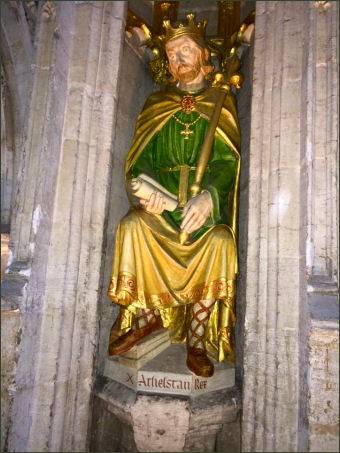
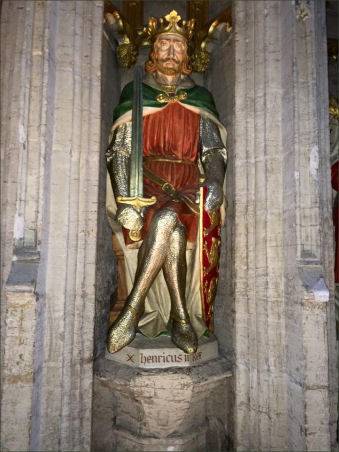
The choir screen, (pictured above) features eight carved and painted kings in canopied niches flanking a central doorway into the choir, with another 24 statues in niches above the doorway arch. The screen, which dates to the fifteenth century, is 8 feet thick. Athough the screen is medieval, the statues are Victorian, and represent both kings, bishops, and saints who played a part in the history of the cathedral.
The superb intricate carving of the oak choir stalls which were completed in 1494 by Ripon woodcarvers, they are amongst most famous and finest choir stalls in the country. The cathedral also has many other interesting features, including the late fifteenth century misericords - the carvings on the back of the choir stall seats (pictured below right) which are superlative surviving examples of medieval craftsmanship. Many of these, including the misericord of a griffon chasing a rabbit down a rabbit hole, are thought to have inspired Charles Lutwidge Dodgson, more famously known as Lewis Carroll, the author of Alice's Adventures in Wonderland, whose father became a residentiary canon of the Cathedral in 1852.
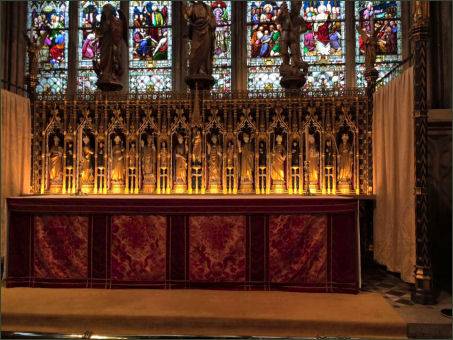
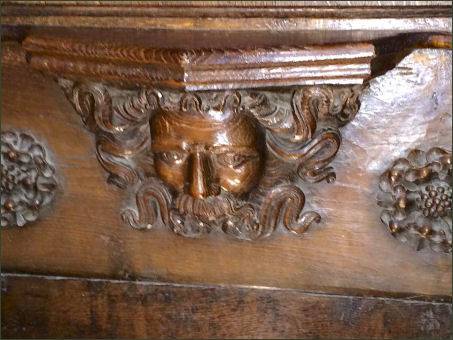
During the First World War, the war poet Wilfred Owen was posted to the Northern Command Depot at Ripon. A number of poems were composed in Ripon, including 'Futility' and 'Strange Meeting'. He is known to have spent some time in and around the Cathedral.
